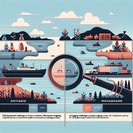
Canadian business travellers heading to Europe will soon face an additional layer of screening not unlike the Electronic Travel Authorization (eTA) Canada introduced in 2016. On 8 November 2025, European officials confirmed that the long-planned Entry/Exit System (EES) is on track for full implementation by 10 April 2026 and will be followed ‘late next year’ by the European Travel Information and Authorisation System (ETIAS). The announcement, reported by Jim Bronskill of The Canadian Press, signals the most sweeping change to Schengen-area border management in more than a decade.
Under EES, non-EU nationals—including Canadians who currently enjoy visa-free access for short stays—will have their passport details, date and place of entry, and biometric data (facial image and four fingerprints) captured at automated kiosks every time they cross an external Schengen frontier. The data will be stored for three years and shared with EU law-enforcement agencies. Officials say the system will deter overstays, accelerate legitimate traffic, and strengthen counter-terrorism controls, but privacy advocates warn of possible data-misuse and profiling risks.
![Europe’s new Entry/Exit System means biometrics and advance clearance for Canadian visitors]()
The second pillar, ETIAS, will require Canadians (and other visa-exempt nationals) to complete an online pre-travel questionnaire, pay a €20 fee, and receive electronic approval that will be valid for three years. Most applications are expected to clear ‘within minutes’, but those that trigger database hits could take up to 30 days. Air carriers will have to verify ETIAS approval before boarding, mirroring carrier-compliance rules used by Canada and the United States.
For multinationals and mobility managers, the lead-time is short. Employers should audit upcoming assignment schedules, update traveller briefings, and budget for possible airport bottlenecks during the transition period. Frequent travellers may wish to enrol in Registered-Traveller lanes where available, and companies should review data-protection clauses in travel-management contracts as biometric information becomes part of the journey.
Although EES/ETIAS do not alter the 90/180-day stay rule, missing documentation could force denied boarding or entry refusal—potentially derailing high-stakes meetings or project timelines. Travel-risk teams are therefore advising staff to apply for ETIAS as soon as the portal opens and to retain paper evidence of onward itineraries and accommodation just in case border staff request extra proof.
Under EES, non-EU nationals—including Canadians who currently enjoy visa-free access for short stays—will have their passport details, date and place of entry, and biometric data (facial image and four fingerprints) captured at automated kiosks every time they cross an external Schengen frontier. The data will be stored for three years and shared with EU law-enforcement agencies. Officials say the system will deter overstays, accelerate legitimate traffic, and strengthen counter-terrorism controls, but privacy advocates warn of possible data-misuse and profiling risks.

The second pillar, ETIAS, will require Canadians (and other visa-exempt nationals) to complete an online pre-travel questionnaire, pay a €20 fee, and receive electronic approval that will be valid for three years. Most applications are expected to clear ‘within minutes’, but those that trigger database hits could take up to 30 days. Air carriers will have to verify ETIAS approval before boarding, mirroring carrier-compliance rules used by Canada and the United States.
For multinationals and mobility managers, the lead-time is short. Employers should audit upcoming assignment schedules, update traveller briefings, and budget for possible airport bottlenecks during the transition period. Frequent travellers may wish to enrol in Registered-Traveller lanes where available, and companies should review data-protection clauses in travel-management contracts as biometric information becomes part of the journey.
Although EES/ETIAS do not alter the 90/180-day stay rule, missing documentation could force denied boarding or entry refusal—potentially derailing high-stakes meetings or project timelines. Travel-risk teams are therefore advising staff to apply for ETIAS as soon as the portal opens and to retain paper evidence of onward itineraries and accommodation just in case border staff request extra proof.










